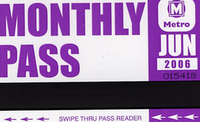Transit pricing: Time to go “all you can eat”?
When you pay for transportation, whether it’s for driving a private car or taking mass transit, there’s a continuum of payment methods, with “pay-per-use” on one end of the scale, and “unlimited use” on the other.
Does the choice of method matter? It should. People make choices about how they get around based on how much the next trip costs them. With unlimited use, the next trip is free. With pay per use, the next trip can cost a lot, because not only are you paying the cost of an additional trip, but you’re paying a fraction of the fixed costs.
Most people pay per trip for transit in the Washington region. Meanwhile, many other transit agencies use an “all you can eat” model with their regular customers. In New York City, with the highest transit ridership in the nation, most riders buy weekly or monthly unlimited ride MetroCards. Unlimited ride holders don’t think twice about hopping on the subway for almost any trip. Metro sells about 35,000 unlimited weekly bus passes per week, and about an eighth as many rail passes. We should implement more convenient, reasonably priced monthly or weekly passes. WMATA’s effort to integrate the existing passes with SmarTrip cards is a good start. However, the rail pass is still separate from the bus pass, and the rail pass only makes financial sense for those that ride the longest distances.
The difficulty with rail passes in Washington compared to other systems is distance-based fares. For other systems, the provider chooses a weekly price, which is typically 9-12 single rides. For distance-based fares, how should you choose the price to base it on? If you choose about 10 times the maximum fare, it’s a terrible deal for most and you don’t end up selling many passes. (This is almost what we do currently; it’s $39.00 for a pass and the maximum fare is $4.50.) If you choose 10 times the minimum fare, it’s expensive for the transit agency, and there’s a lot of revenue loss compared to regular fares.
SmarTrip cards are smart enough to have customizable weekly passes. You could choose a fare level and pay ten times that amount per week automatically by subscription. All your rides that are less than that would be free, while any fare above that amount would be deducted from your account balance. This would have the effect of “pay for your commute and the rest is free”. This is just like wireless phone service, where you pay for a certain amount of daytime (peak) minutes and get your nights and weekends for free. Right now WMATA has this policy, but there are only two potential fare levels, at around $26.40 for the cheaper “Short Rail” pass (equivalent to commuting downtown from approximately Bethesda), and $39.00 for the more expensive unlimited rail pass (which would be a good deal for anyone commuting downtown from White Flint or further). Someone who commutes a short distance isn’t likely to buy one. Additionally, the passes are inconvenient, requiring purchase of a paper farecard, and for the short rail pass, carrying exitfare to make up the difference for each trip.
In addition to having reasonably priced unlimited passes, some transit agencies have taken the idea of unlimited pricing one step further. For example, the Denver area transit agency, RTD, sells an unlimited pass to an entire employer based on the number of employees and the distance from the city’s downtown and transit centers. This is a form of insurance that spreads the cost out socially in order to provide a benefit. In this case, employers enjoy reduced parking costs and employees get free transit. The transit agency prices the passes to assure revenue neutrality. For a much lower price per employee than single pass purchases, everyone gets an unlimited yearly pass. The price per employee is lower (between $50 and $400 compared to $1800 for an annual pass) because the transit agency assumes some people will not use it.
Transit agencies still get the same amount of revenue, but instead of paying for each trip, the employees don’t pay anything extra. This program reduced the number of parking spaces needed for Colorado UniversityUniversity of Colorado, and increased the number of employees taking public transit downtown. Boulder City staff were happy to talk to me about the program. Based on the materials they provided, the program seems like steroids for transit. People are many times more likely to use transit, even buses, when they have the pass. Neighborhoods are allowed to organize and buy passes for everyone on the block edit: RTD has placed a moratorium on new neighborhoods entering the program as they work to collect data from a soon-to-be-released smartcard. Even though the price of a ECO pass has risen dramatically (RTD has hiked the prices more than 50% since 2003), so has transit ridership and pass usage.
Unlimited passes are also an interesting idea for sporting or entertainment events. In that case, the stadium or ballpark would add a fee for every ticket, transferring the revenue to the transit agency. In exchange, the sporting event tickets would act as a day pass (perhaps after a certain time in the afternoon).
Having to pay for something creates a psychological obstacle to consuming more of it. In the case of transit, we want to lower those hurdles, especially off-peak where our transit systems have excess capacity, and more riders mean more revenue but not higher costs. “All you can eat” pricing does just that.


